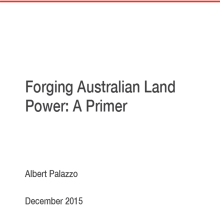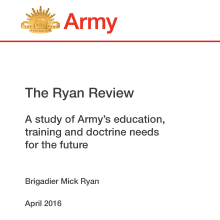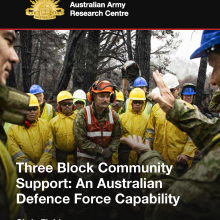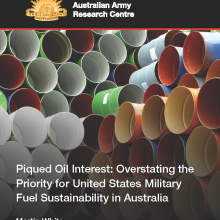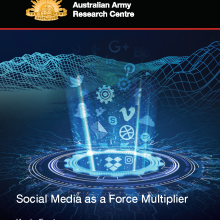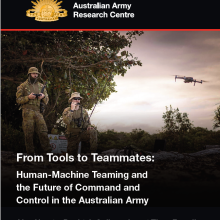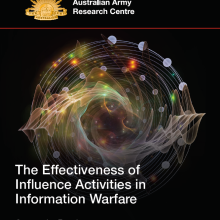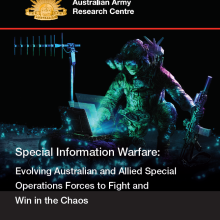Search
Using the filters to the left, click your selection, it will become bold and filter the results, click it again to remove that filter.
Army in the 21st Century (A21) and Restructuring the Army (RTA) were two related force structure initiatives undertaken by the Australian Army in the 1990s. A21 radically proposed to abolish traditional divisional/corps structures, fielding instead independent task forces with embedded combat arms. The RTA trials tested A21 concepts and capabilities over several years; yet A21/RTA was abandoned in 1999. What happened, why, and what lessons does A21/RTA offer? This retrospective appraisal of A21/RTA is a …
For military organisations, the aftermath of a war represents an opportunity to rest and refit, to think about the lessons so painfully learned and to preserve those of enduring value in education, training and doctrine. Arguably of even more importance, it is a time to reflect on and ask basic questions about the character of war: what has changed, what has remained the same, and what opportunities and challenges are suggested for the future evolution of the wars that are yet to come. Albert Palazzo’s …
A study of Army’s education, training and doctrine needs for the future Introduction The Army lives in the school house. The quote above, from Lieutenant General Frank Hickling (retired) in January this year, has been at the forefront of my mind since I commenced this appointment. This study was established in order to gain an appreciation of the current strengths and weaknesses of Army’s approach to education, training and doctrine, and to then propose how we might rectify the challenges identified. There …
Over the past 100 years, the manner in which the infantry battalion is employed has undergone revolutionary change— something that is not always appreciated by those who regard the infantry as the unskilled labour force of the battlefield. In fact, nothing could be further from the truth. This paper discusses the implications of the transition from relatively unskilled mass industrial-age infantry to the information-age specialists who dominate the modern battlespace. Oddly, these changes have not been …
Introduction During humanitarian and disaster relief responses, the Australian Defence Force (ADF) may be required to work on several different levels at once. In one moment in time, our ADF members support communities, volunteers, emergency responders and their leaders. In the next moment, they provide teams for evacuation, clean-up, clearance and repair tasks. Finally, they utilise their core skills, such as sea, land and air mobility, logistics, communications, medical and engineering—all on the same …
Overstating the Priority for United States Military Fuel Sustainability in Australia Abstract Reducing the United States military’s petroleum consumption became a declared Obama Administration-era policy. This policy was often framed as a measure to address the tactical losses suffered during fuel supply operations in the Middle East, but there were notable links to environmental and broader energy security agendas. While the US military undertook a large number of mostly modest initiatives to reduce …
Introduction: The Changed Face of War This report examines how the Australian Army’s engagement with and use of social media compares to that of a selection of its allied and comparator militaries. It finds that, despite the welcome establishment of the Information Warfare Division (IWD) in July 2017, Army continues to trail its allies and is a long way behind best practice in its adoption of, adaptation to and use of social media as a capability in the contest for information advantage against its …
Human-Machine Teaming and the Future of Command and Control in the Australian Army Abstract In 2018, the Australian Army launched its Robotic and Autonomous Systems Strategy to capitalise on the military opportunities presented by the much-anticipated ‘fourth industrial revolution’ in artificial intelligence and machine learning software. The key to realising this potential lies in the effective integration of soldiers and autonomous systems, known as human-machine teaming. Through human-machine teaming, …
Abstract Rapid, globalised power shifts, technological advances, and increasingly interconnected, ungoverned communications networks have resulted in the rise of asymmetric grey zone threats. The lines are now blurred between political, civil, and military information environments. The rise of influence activities is the new ‘sharp power’ in information warfare (the iWar). Western democracies are already at war in the information domain and are being out-communicated by their adversaries. Building on the …
Evolving Australian and Allied Special Operations Forces to Fight and Win in the Chaos Foreword The contemporary conflict environment is complex, cluttered and highly connected. In an urbanised, heavily populated, informationally dense environment, regular armed forces (including the ADF) now face an enormously varied and lethal range of both state and non-state threats. As Benny Johanson notes in this paper, the explosion of electronic connectivity since the turn of the century and the resulting rise in …

